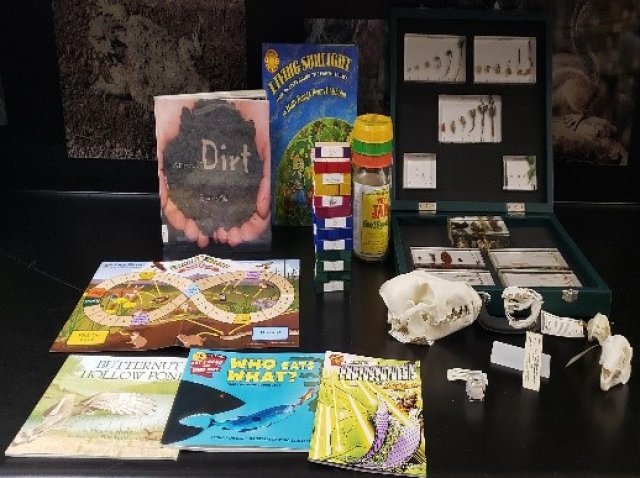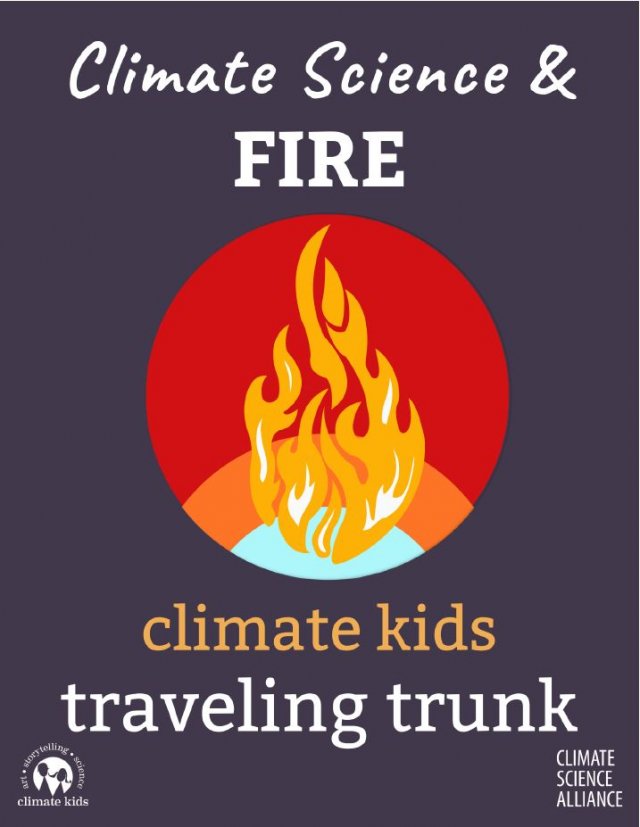Bring the natural world into your classroom with our Teacher Kits. Each kit includes lesson plans, books, materials and Museum specimens to engage and inspire your students. All lesson plans are aligned with California State and NGSS Standards.
All Teacher Kits are available to the Barn Owl and Great Horned Owl level members for a two-week loan. The Barn Owl level membership includes one free Teacher Kit check out and the Great Horned Owl level membership includes two free Teacher Kit check outs. Additional kits are available for $30.
Do you know a teacher who might be looking to add some nature to their curriculum? Membership makes a great gift for teachers!
Contact us to learn more: loanprogram@sdnhm.org or 619.255.0236.
A special thank you to our partners at Climate Science Alliance and their Climate Kids Traveling Trunks.

The Kumeyaay People share a relationship with nature, native plants, and the animals around them. This kit allows students to explore the lives of the first people to inhabit San Diego County. Students will grind acorns, discover how plants and animals provided food, clothing and shelter and explore some Kumeyaay traditions. View Curriculum
Ask Question
Where does water go when it rains? Students will learn what a watershed is and why it is important. This hands-on model encourages students to "make it rain," allowing for a better understanding of human impact on water quality. Students will also discover the areas that feed into our watersheds, thus providing a greater connection to their water source.
Ask Question
Through science, art, and storytelling activities, students will gain a deeper understanding of carnivores and their importance in our region. Investigate how a changing climate and increased human activity will affect these animals and their connections to the circle of life. This Climate Kids Traveling Trunk is brought to you in partnership with the Climate Science Alliance. View Curriculum Overview
Ask Question
Study the impact of climate change on marine ecosystems. Through ocean acidification and warming, students will learn the current climate science. Though art, storytelling, and hands-on science activities, students will gain a better understanding of the impact on our oceans. This Climate Kids Traveling Trunk is brought to you in partnership with the Climate Science Alliance. View Curriculum Overview
Ask Question
Invite students to explore pollinators and the important role they play in our lives. How will a changing climate plus increased human activity affect them and our food production? Find the answer to these questions with hands-on science activities, art, and storytelling. This Climate Kids Traveling Trunk is brought to you in partnership with the Climate Science Alliance. View Curriculum Overview
Ask Question
Discover the splendor and science that exists right under your feet! San Diego is one of the most famous gem-producing regions in the world, but where do these minerals come from? How do they form? Why are rocks and minerals important in our lives? This kit will help students answer these questions and more as we explore the dynamic forces of our continually changing earth. View Curriculum
Ask Question
Students will have the chance to see what is like to be a geologist, paleontologist, and an engineer. They will learn about the mysteries and wonders of the earth through rock, mineral, and fossil investigations. Hands-on activities and themed books will build an understanding of the various causes for earth's changes. Students will construct a building and test their engineering skills to create an earthquake-proof structure. Our earth is an amazing place, from fossils to human ingenuity. Let's jump in and get rockin'! View Curriculum
Ask Question
What do living things need to survive? Just like humans, animal parents must care for, feed, and protect their young. Through storytelling and hands-on activities, students will discover how plants and animals are suited to exist in their surroundings. This kit includes specimens to help students identify special structures and functions of a particular plant or animal. Students will create a solution to an everyday problem by finding inspiration from nature. View Curriculum
Ask Question
Life on earth is incredibly diverse. Evolution has resulted in a vast number of adaptations for survival. This kit helps students develop an understanding of both the similarities and differences of an organisms' life cycle. These lessons include hands-on activities, specimens, and supporting literature. Students will investigate 12 different life cycles, including a chicken, salmon, praying mantis, and bean plant, and try their hand at a life cycle board game. View Curriculum
Ask Question
What are we made of? How do plants and animals get the energy needed to grow and thrive? Students will explore these answers and the movement of matter and energy through ecosystems. Through lab experiments and games, students will gain understanding of the building blocks of life. View Curriculum
Ask Question
Help students gain a better understanding of how climate change affects our food system and agricultural practices. The hands-on science activities, storytelling, and art materials in this trunk specifically target K-12 grade students based on Next Generation Science Standards. This Climate Kids Traveling Trunk is brought to you in partnership with the Climate Science Alliance. View Curriculum Overview
Ask Question
Bring to life aerosols - one of the most poorly understood components of Earth's atmosphere - and their impact on our lives and the changing climate. Through science, art, and storytelling activities, students will gain an understanding of the current science behind atmospheric chemistry and the impact of aerosols on climate and public health. See how scientists are working to understand the issues we face at the intersection of these topics. This Climate Kids Traveling Trunk is brought to you in partnership with the Climate Science Alliance. View Curriculum Overview
Ask Question
Weather is sunshine, rain, wind, and storms. It’s what is going on outside right now. Using this kit, students will observe, track, and predict the weather. Each day we choose what to wear depending on the weather, but knowing more can help us protect life and property as well. These materials also take a look at climate and how it differs from the weather. Finally, students will take the first steps toward understanding climate change and what it means for our future. View Curriculum
Ask Question
Plants have developed special adaptations for survival in the different habitats in which they occur. Our researchers study plants in the Baja California Peninsula, looking at their unique adaptations and the relationships they have with other species in their region. Students will get a chance to step in the shoes of our botanists; identifying plant specimens, discovering the unique ways that plant and animal species are connected, learning to use a plant press, and much more! View Curriculum
Ask Question
Manage stormwater pollution and flooding in your watershed with EnviroScape Ecological Restoration (Wetlands & Floodplain Management). Demonstrate how wetland and floodplain management can improve the environment! Experiment with restoring the environment to reduce the negative effects of unplanned development. Demonstrate flooding on the floodplain.
Ask Question
Show what happens when hazardous materials/waste are improperly discharged, disposed or accidentally spilled & ways to clean up and prevent it. From underground storage tanks and illegal dumping to transportation and household/residential and commercial practices... & more! This teaching model communicates to all ages (children to adults)!
Ask Question
The Climate Science & Fire Traveling Trunk contains the resources and lessons needed for educators to help students gain a better understanding of how southern California’s ecological systems are adapted to wildfires and how that will be affected by a changing climate. Using real data that is regionally specific, the activities in this trunk will help students learn about the importance of fire for southern California ecosystems. There is also an emphasis on Indigenous fire stewardship, fire adaptations of native species, and the effects of climate change on wildfire behavior, intensity and frequency. This Climate Kids Traveling Trunk is brought to you in partnership with the Climate Science Alliance. View Curriculum Overview
Ask Question